An Analysis of Gender Representation and the Male Gaze in Films
VerifiedAdded on 2022/10/12
|9
|3959
|89
Essay
AI Summary
This essay delves into the multifaceted issue of gender representation in film, examining the historical and contemporary portrayal of women in cinema. The analysis begins by highlighting the disparities in character representation, such as the disproportionate number of male speaking roles and the tendency for female characters to be defined by their relationships or appearance. The concept of the male gaze is explored, referencing Laura Mulvey's influential theory and its impact on how women are depicted as objects of sexual pleasure. The paper further investigates feminist film theory, defining its key elements and approaches to analyzing films. The discussion addresses the criteria for feminist films, the challenges male directors face in creating feminist works, and the evolving landscape of gender representation in modern cinema, including the rise of female-centric films and the ongoing debate about achieving true equality in the industry. The essay provides an in-depth exploration of the male gaze in modern day films and discusses the problems that the male directors face in portraying the characters equally and how they should portray male and female characters differently as well as equally.
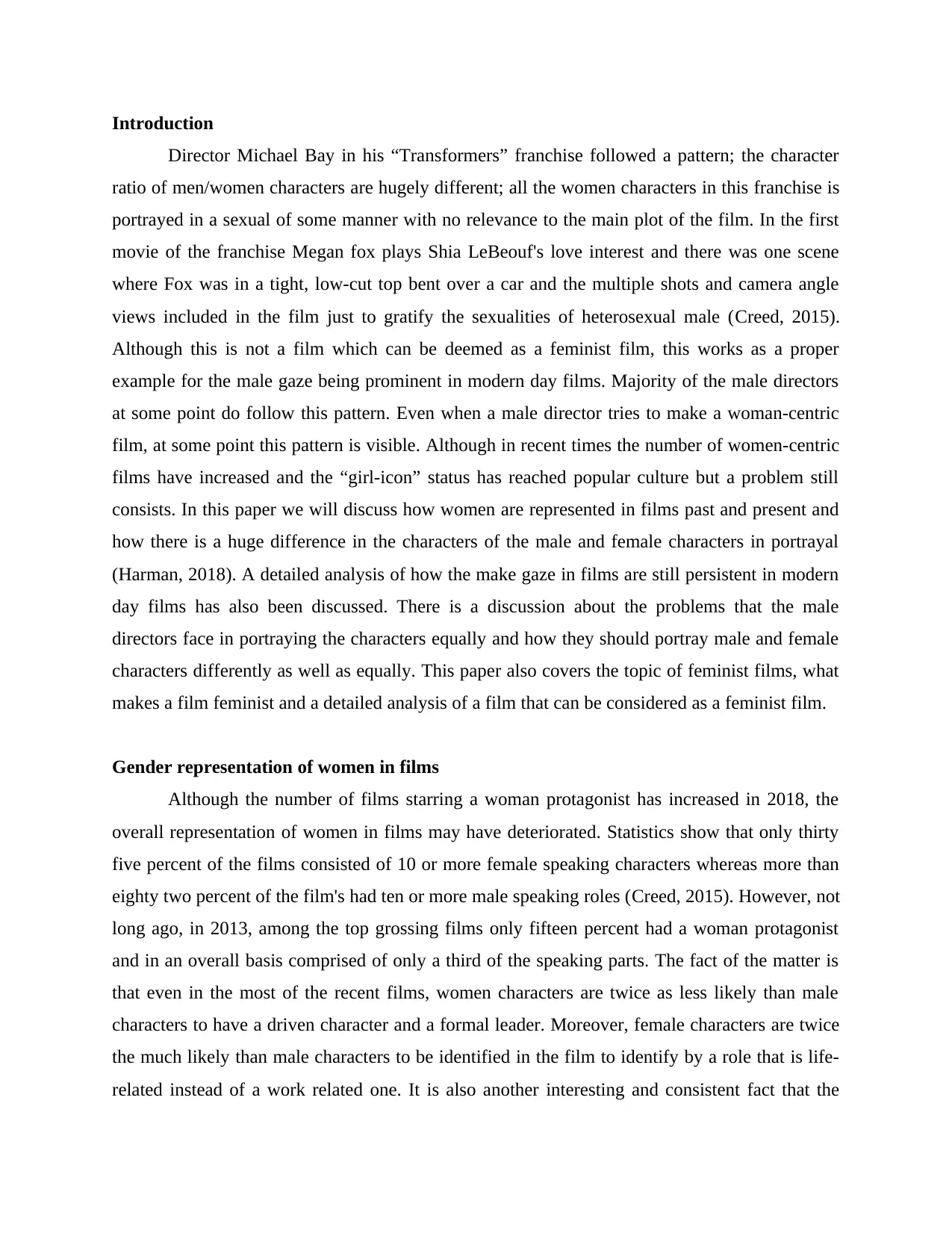
Introduction
Director Michael Bay in his “Transformers” franchise followed a pattern; the character
ratio of men/women characters are hugely different; all the women characters in this franchise is
portrayed in a sexual of some manner with no relevance to the main plot of the film. In the first
movie of the franchise Megan fox plays Shia LeBeouf's love interest and there was one scene
where Fox was in a tight, low-cut top bent over a car and the multiple shots and camera angle
views included in the film just to gratify the sexualities of heterosexual male (Creed, 2015).
Although this is not a film which can be deemed as a feminist film, this works as a proper
example for the male gaze being prominent in modern day films. Majority of the male directors
at some point do follow this pattern. Even when a male director tries to make a woman-centric
film, at some point this pattern is visible. Although in recent times the number of women-centric
films have increased and the “girl-icon” status has reached popular culture but a problem still
consists. In this paper we will discuss how women are represented in films past and present and
how there is a huge difference in the characters of the male and female characters in portrayal
(Harman, 2018). A detailed analysis of how the make gaze in films are still persistent in modern
day films has also been discussed. There is a discussion about the problems that the male
directors face in portraying the characters equally and how they should portray male and female
characters differently as well as equally. This paper also covers the topic of feminist films, what
makes a film feminist and a detailed analysis of a film that can be considered as a feminist film.
Gender representation of women in films
Although the number of films starring a woman protagonist has increased in 2018, the
overall representation of women in films may have deteriorated. Statistics show that only thirty
five percent of the films consisted of 10 or more female speaking characters whereas more than
eighty two percent of the film's had ten or more male speaking roles (Creed, 2015). However, not
long ago, in 2013, among the top grossing films only fifteen percent had a woman protagonist
and in an overall basis comprised of only a third of the speaking parts. The fact of the matter is
that even in the most of the recent films, women characters are twice as less likely than male
characters to have a driven character and a formal leader. Moreover, female characters are twice
the much likely than male characters to be identified in the film to identify by a role that is life-
related instead of a work related one. It is also another interesting and consistent fact that the
Director Michael Bay in his “Transformers” franchise followed a pattern; the character
ratio of men/women characters are hugely different; all the women characters in this franchise is
portrayed in a sexual of some manner with no relevance to the main plot of the film. In the first
movie of the franchise Megan fox plays Shia LeBeouf's love interest and there was one scene
where Fox was in a tight, low-cut top bent over a car and the multiple shots and camera angle
views included in the film just to gratify the sexualities of heterosexual male (Creed, 2015).
Although this is not a film which can be deemed as a feminist film, this works as a proper
example for the male gaze being prominent in modern day films. Majority of the male directors
at some point do follow this pattern. Even when a male director tries to make a woman-centric
film, at some point this pattern is visible. Although in recent times the number of women-centric
films have increased and the “girl-icon” status has reached popular culture but a problem still
consists. In this paper we will discuss how women are represented in films past and present and
how there is a huge difference in the characters of the male and female characters in portrayal
(Harman, 2018). A detailed analysis of how the make gaze in films are still persistent in modern
day films has also been discussed. There is a discussion about the problems that the male
directors face in portraying the characters equally and how they should portray male and female
characters differently as well as equally. This paper also covers the topic of feminist films, what
makes a film feminist and a detailed analysis of a film that can be considered as a feminist film.
Gender representation of women in films
Although the number of films starring a woman protagonist has increased in 2018, the
overall representation of women in films may have deteriorated. Statistics show that only thirty
five percent of the films consisted of 10 or more female speaking characters whereas more than
eighty two percent of the film's had ten or more male speaking roles (Creed, 2015). However, not
long ago, in 2013, among the top grossing films only fifteen percent had a woman protagonist
and in an overall basis comprised of only a third of the speaking parts. The fact of the matter is
that even in the most of the recent films, women characters are twice as less likely than male
characters to have a driven character and a formal leader. Moreover, female characters are twice
the much likely than male characters to be identified in the film to identify by a role that is life-
related instead of a work related one. It is also another interesting and consistent fact that the
Paraphrase This Document
Need a fresh take? Get an instant paraphrase of this document with our AI Paraphraser
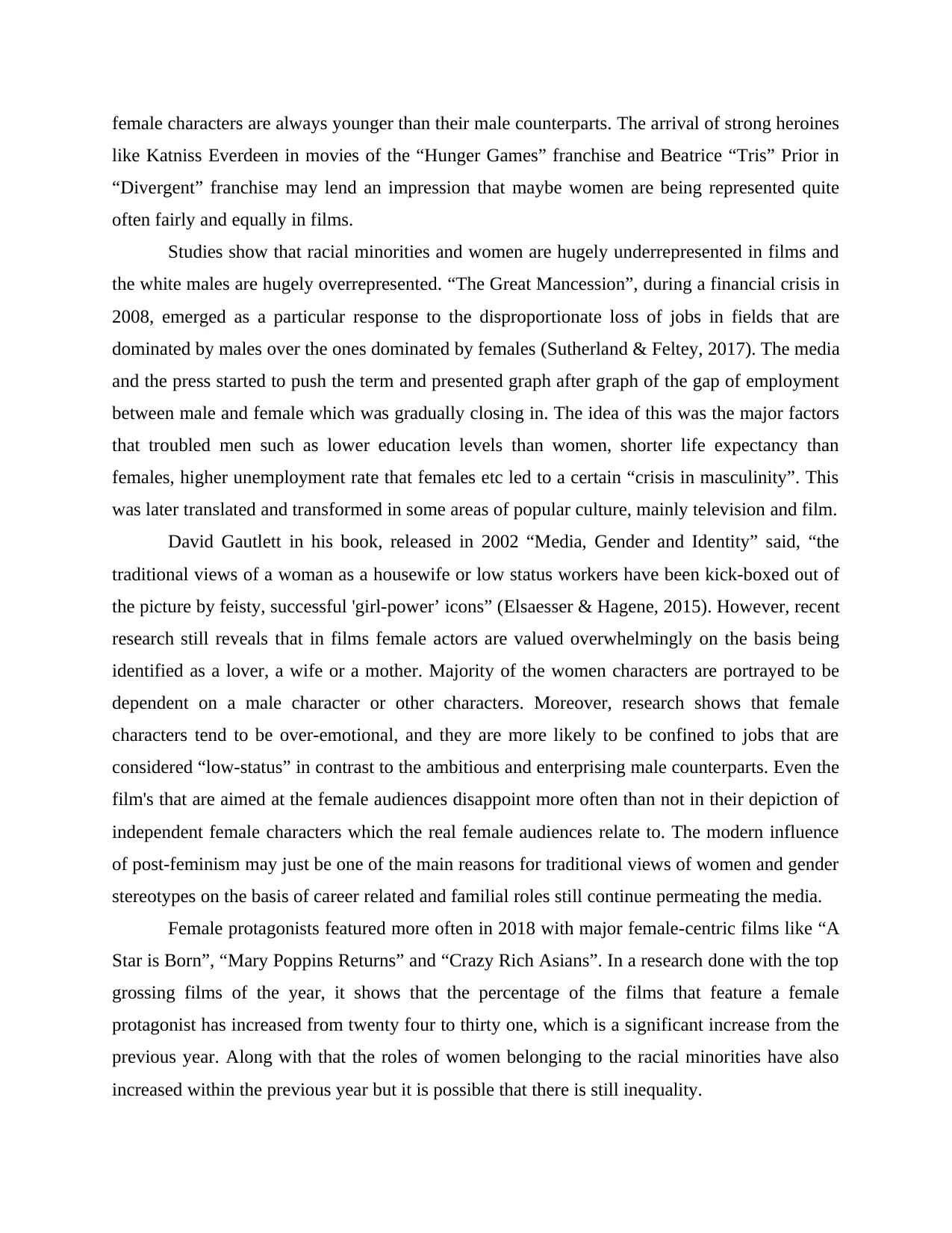
female characters are always younger than their male counterparts. The arrival of strong heroines
like Katniss Everdeen in movies of the “Hunger Games” franchise and Beatrice “Tris” Prior in
“Divergent” franchise may lend an impression that maybe women are being represented quite
often fairly and equally in films.
Studies show that racial minorities and women are hugely underrepresented in films and
the white males are hugely overrepresented. “The Great Mancession”, during a financial crisis in
2008, emerged as a particular response to the disproportionate loss of jobs in fields that are
dominated by males over the ones dominated by females (Sutherland & Feltey, 2017). The media
and the press started to push the term and presented graph after graph of the gap of employment
between male and female which was gradually closing in. The idea of this was the major factors
that troubled men such as lower education levels than women, shorter life expectancy than
females, higher unemployment rate that females etc led to a certain “crisis in masculinity”. This
was later translated and transformed in some areas of popular culture, mainly television and film.
David Gautlett in his book, released in 2002 “Media, Gender and Identity” said, “the
traditional views of a woman as a housewife or low status workers have been kick-boxed out of
the picture by feisty, successful 'girl-power’ icons” (Elsaesser & Hagene, 2015). However, recent
research still reveals that in films female actors are valued overwhelmingly on the basis being
identified as a lover, a wife or a mother. Majority of the women characters are portrayed to be
dependent on a male character or other characters. Moreover, research shows that female
characters tend to be over-emotional, and they are more likely to be confined to jobs that are
considered “low-status” in contrast to the ambitious and enterprising male counterparts. Even the
film's that are aimed at the female audiences disappoint more often than not in their depiction of
independent female characters which the real female audiences relate to. The modern influence
of post-feminism may just be one of the main reasons for traditional views of women and gender
stereotypes on the basis of career related and familial roles still continue permeating the media.
Female protagonists featured more often in 2018 with major female-centric films like “A
Star is Born”, “Mary Poppins Returns” and “Crazy Rich Asians”. In a research done with the top
grossing films of the year, it shows that the percentage of the films that feature a female
protagonist has increased from twenty four to thirty one, which is a significant increase from the
previous year. Along with that the roles of women belonging to the racial minorities have also
increased within the previous year but it is possible that there is still inequality.
like Katniss Everdeen in movies of the “Hunger Games” franchise and Beatrice “Tris” Prior in
“Divergent” franchise may lend an impression that maybe women are being represented quite
often fairly and equally in films.
Studies show that racial minorities and women are hugely underrepresented in films and
the white males are hugely overrepresented. “The Great Mancession”, during a financial crisis in
2008, emerged as a particular response to the disproportionate loss of jobs in fields that are
dominated by males over the ones dominated by females (Sutherland & Feltey, 2017). The media
and the press started to push the term and presented graph after graph of the gap of employment
between male and female which was gradually closing in. The idea of this was the major factors
that troubled men such as lower education levels than women, shorter life expectancy than
females, higher unemployment rate that females etc led to a certain “crisis in masculinity”. This
was later translated and transformed in some areas of popular culture, mainly television and film.
David Gautlett in his book, released in 2002 “Media, Gender and Identity” said, “the
traditional views of a woman as a housewife or low status workers have been kick-boxed out of
the picture by feisty, successful 'girl-power’ icons” (Elsaesser & Hagene, 2015). However, recent
research still reveals that in films female actors are valued overwhelmingly on the basis being
identified as a lover, a wife or a mother. Majority of the women characters are portrayed to be
dependent on a male character or other characters. Moreover, research shows that female
characters tend to be over-emotional, and they are more likely to be confined to jobs that are
considered “low-status” in contrast to the ambitious and enterprising male counterparts. Even the
film's that are aimed at the female audiences disappoint more often than not in their depiction of
independent female characters which the real female audiences relate to. The modern influence
of post-feminism may just be one of the main reasons for traditional views of women and gender
stereotypes on the basis of career related and familial roles still continue permeating the media.
Female protagonists featured more often in 2018 with major female-centric films like “A
Star is Born”, “Mary Poppins Returns” and “Crazy Rich Asians”. In a research done with the top
grossing films of the year, it shows that the percentage of the films that feature a female
protagonist has increased from twenty four to thirty one, which is a significant increase from the
previous year. Along with that the roles of women belonging to the racial minorities have also
increased within the previous year but it is possible that there is still inequality.
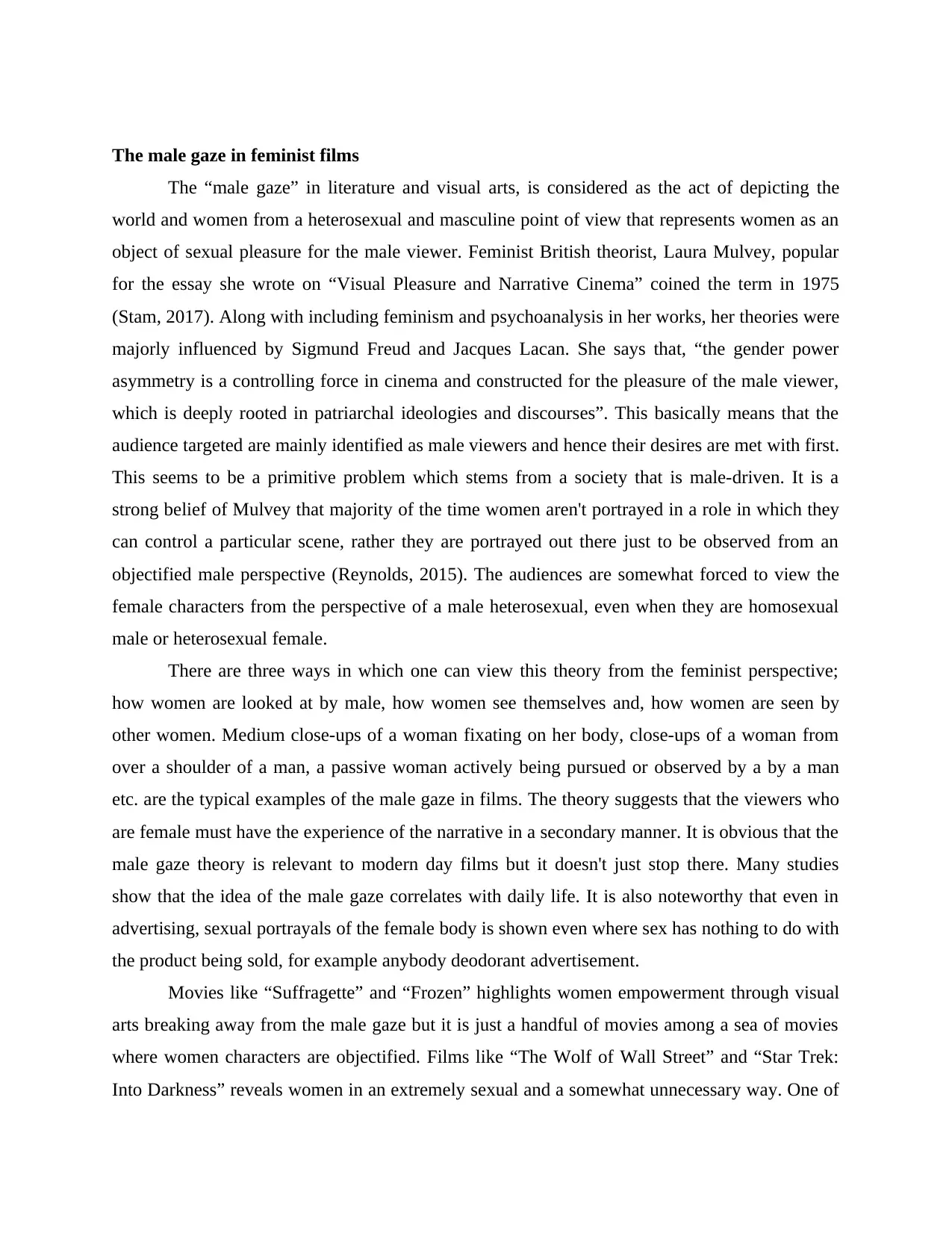
The male gaze in feminist films
The “male gaze” in literature and visual arts, is considered as the act of depicting the
world and women from a heterosexual and masculine point of view that represents women as an
object of sexual pleasure for the male viewer. Feminist British theorist, Laura Mulvey, popular
for the essay she wrote on “Visual Pleasure and Narrative Cinema” coined the term in 1975
(Stam, 2017). Along with including feminism and psychoanalysis in her works, her theories were
majorly influenced by Sigmund Freud and Jacques Lacan. She says that, “the gender power
asymmetry is a controlling force in cinema and constructed for the pleasure of the male viewer,
which is deeply rooted in patriarchal ideologies and discourses”. This basically means that the
audience targeted are mainly identified as male viewers and hence their desires are met with first.
This seems to be a primitive problem which stems from a society that is male-driven. It is a
strong belief of Mulvey that majority of the time women aren't portrayed in a role in which they
can control a particular scene, rather they are portrayed out there just to be observed from an
objectified male perspective (Reynolds, 2015). The audiences are somewhat forced to view the
female characters from the perspective of a male heterosexual, even when they are homosexual
male or heterosexual female.
There are three ways in which one can view this theory from the feminist perspective;
how women are looked at by male, how women see themselves and, how women are seen by
other women. Medium close-ups of a woman fixating on her body, close-ups of a woman from
over a shoulder of a man, a passive woman actively being pursued or observed by a by a man
etc. are the typical examples of the male gaze in films. The theory suggests that the viewers who
are female must have the experience of the narrative in a secondary manner. It is obvious that the
male gaze theory is relevant to modern day films but it doesn't just stop there. Many studies
show that the idea of the male gaze correlates with daily life. It is also noteworthy that even in
advertising, sexual portrayals of the female body is shown even where sex has nothing to do with
the product being sold, for example anybody deodorant advertisement.
Movies like “Suffragette” and “Frozen” highlights women empowerment through visual
arts breaking away from the male gaze but it is just a handful of movies among a sea of movies
where women characters are objectified. Films like “The Wolf of Wall Street” and “Star Trek:
Into Darkness” reveals women in an extremely sexual and a somewhat unnecessary way. One of
The “male gaze” in literature and visual arts, is considered as the act of depicting the
world and women from a heterosexual and masculine point of view that represents women as an
object of sexual pleasure for the male viewer. Feminist British theorist, Laura Mulvey, popular
for the essay she wrote on “Visual Pleasure and Narrative Cinema” coined the term in 1975
(Stam, 2017). Along with including feminism and psychoanalysis in her works, her theories were
majorly influenced by Sigmund Freud and Jacques Lacan. She says that, “the gender power
asymmetry is a controlling force in cinema and constructed for the pleasure of the male viewer,
which is deeply rooted in patriarchal ideologies and discourses”. This basically means that the
audience targeted are mainly identified as male viewers and hence their desires are met with first.
This seems to be a primitive problem which stems from a society that is male-driven. It is a
strong belief of Mulvey that majority of the time women aren't portrayed in a role in which they
can control a particular scene, rather they are portrayed out there just to be observed from an
objectified male perspective (Reynolds, 2015). The audiences are somewhat forced to view the
female characters from the perspective of a male heterosexual, even when they are homosexual
male or heterosexual female.
There are three ways in which one can view this theory from the feminist perspective;
how women are looked at by male, how women see themselves and, how women are seen by
other women. Medium close-ups of a woman fixating on her body, close-ups of a woman from
over a shoulder of a man, a passive woman actively being pursued or observed by a by a man
etc. are the typical examples of the male gaze in films. The theory suggests that the viewers who
are female must have the experience of the narrative in a secondary manner. It is obvious that the
male gaze theory is relevant to modern day films but it doesn't just stop there. Many studies
show that the idea of the male gaze correlates with daily life. It is also noteworthy that even in
advertising, sexual portrayals of the female body is shown even where sex has nothing to do with
the product being sold, for example anybody deodorant advertisement.
Movies like “Suffragette” and “Frozen” highlights women empowerment through visual
arts breaking away from the male gaze but it is just a handful of movies among a sea of movies
where women characters are objectified. Films like “The Wolf of Wall Street” and “Star Trek:
Into Darkness” reveals women in an extremely sexual and a somewhat unnecessary way. One of
⊘ This is a preview!⊘
Do you want full access?
Subscribe today to unlock all pages.

Trusted by 1+ million students worldwide
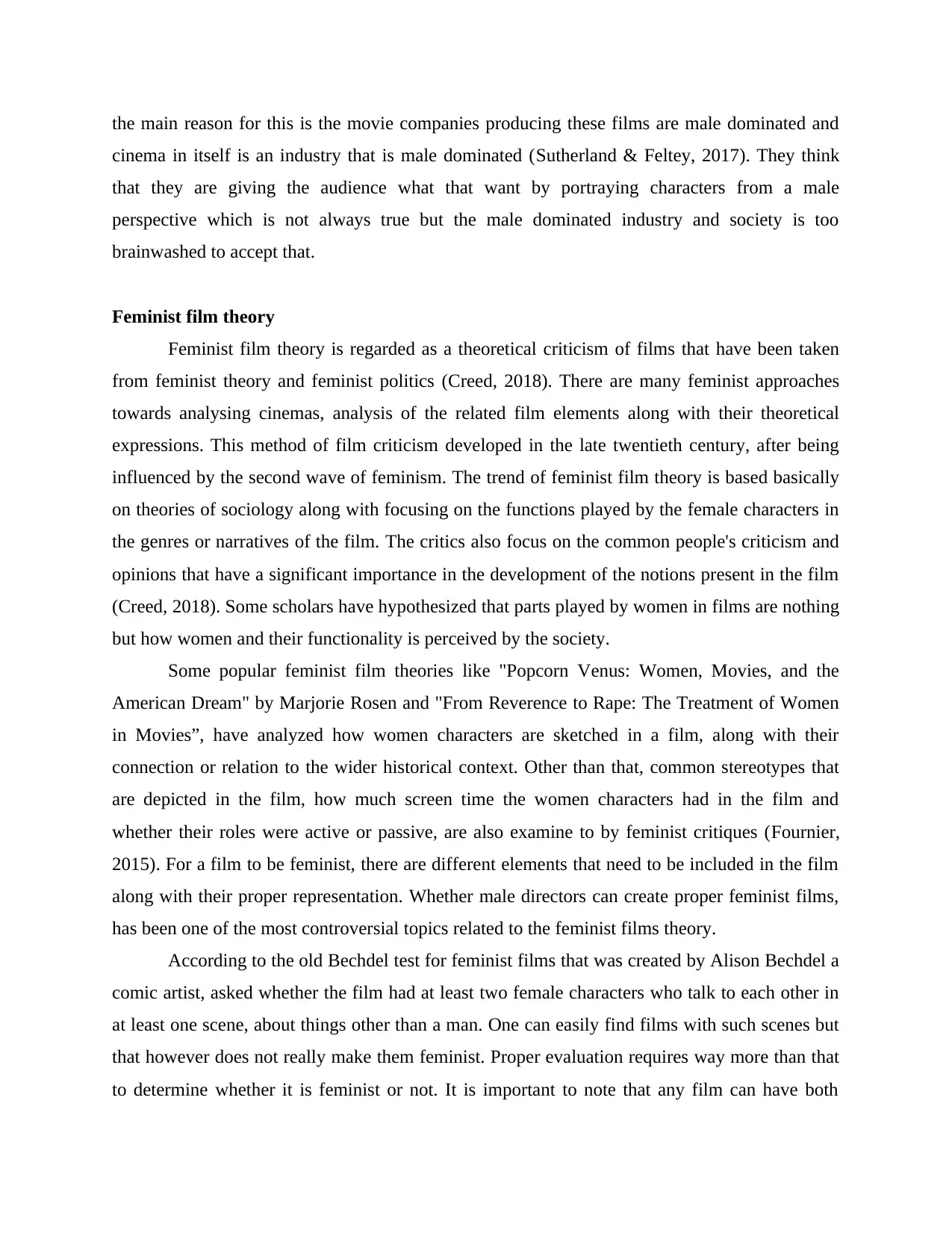
the main reason for this is the movie companies producing these films are male dominated and
cinema in itself is an industry that is male dominated (Sutherland & Feltey, 2017). They think
that they are giving the audience what that want by portraying characters from a male
perspective which is not always true but the male dominated industry and society is too
brainwashed to accept that.
Feminist film theory
Feminist film theory is regarded as a theoretical criticism of films that have been taken
from feminist theory and feminist politics (Creed, 2018). There are many feminist approaches
towards analysing cinemas, analysis of the related film elements along with their theoretical
expressions. This method of film criticism developed in the late twentieth century, after being
influenced by the second wave of feminism. The trend of feminist film theory is based basically
on theories of sociology along with focusing on the functions played by the female characters in
the genres or narratives of the film. The critics also focus on the common people's criticism and
opinions that have a significant importance in the development of the notions present in the film
(Creed, 2018). Some scholars have hypothesized that parts played by women in films are nothing
but how women and their functionality is perceived by the society.
Some popular feminist film theories like "Popcorn Venus: Women, Movies, and the
American Dream" by Marjorie Rosen and "From Reverence to Rape: The Treatment of Women
in Movies”, have analyzed how women characters are sketched in a film, along with their
connection or relation to the wider historical context. Other than that, common stereotypes that
are depicted in the film, how much screen time the women characters had in the film and
whether their roles were active or passive, are also examine to by feminist critiques (Fournier,
2015). For a film to be feminist, there are different elements that need to be included in the film
along with their proper representation. Whether male directors can create proper feminist films,
has been one of the most controversial topics related to the feminist films theory.
According to the old Bechdel test for feminist films that was created by Alison Bechdel a
comic artist, asked whether the film had at least two female characters who talk to each other in
at least one scene, about things other than a man. One can easily find films with such scenes but
that however does not really make them feminist. Proper evaluation requires way more than that
to determine whether it is feminist or not. It is important to note that any film can have both
cinema in itself is an industry that is male dominated (Sutherland & Feltey, 2017). They think
that they are giving the audience what that want by portraying characters from a male
perspective which is not always true but the male dominated industry and society is too
brainwashed to accept that.
Feminist film theory
Feminist film theory is regarded as a theoretical criticism of films that have been taken
from feminist theory and feminist politics (Creed, 2018). There are many feminist approaches
towards analysing cinemas, analysis of the related film elements along with their theoretical
expressions. This method of film criticism developed in the late twentieth century, after being
influenced by the second wave of feminism. The trend of feminist film theory is based basically
on theories of sociology along with focusing on the functions played by the female characters in
the genres or narratives of the film. The critics also focus on the common people's criticism and
opinions that have a significant importance in the development of the notions present in the film
(Creed, 2018). Some scholars have hypothesized that parts played by women in films are nothing
but how women and their functionality is perceived by the society.
Some popular feminist film theories like "Popcorn Venus: Women, Movies, and the
American Dream" by Marjorie Rosen and "From Reverence to Rape: The Treatment of Women
in Movies”, have analyzed how women characters are sketched in a film, along with their
connection or relation to the wider historical context. Other than that, common stereotypes that
are depicted in the film, how much screen time the women characters had in the film and
whether their roles were active or passive, are also examine to by feminist critiques (Fournier,
2015). For a film to be feminist, there are different elements that need to be included in the film
along with their proper representation. Whether male directors can create proper feminist films,
has been one of the most controversial topics related to the feminist films theory.
According to the old Bechdel test for feminist films that was created by Alison Bechdel a
comic artist, asked whether the film had at least two female characters who talk to each other in
at least one scene, about things other than a man. One can easily find films with such scenes but
that however does not really make them feminist. Proper evaluation requires way more than that
to determine whether it is feminist or not. It is important to note that any film can have both
Paraphrase This Document
Need a fresh take? Get an instant paraphrase of this document with our AI Paraphraser
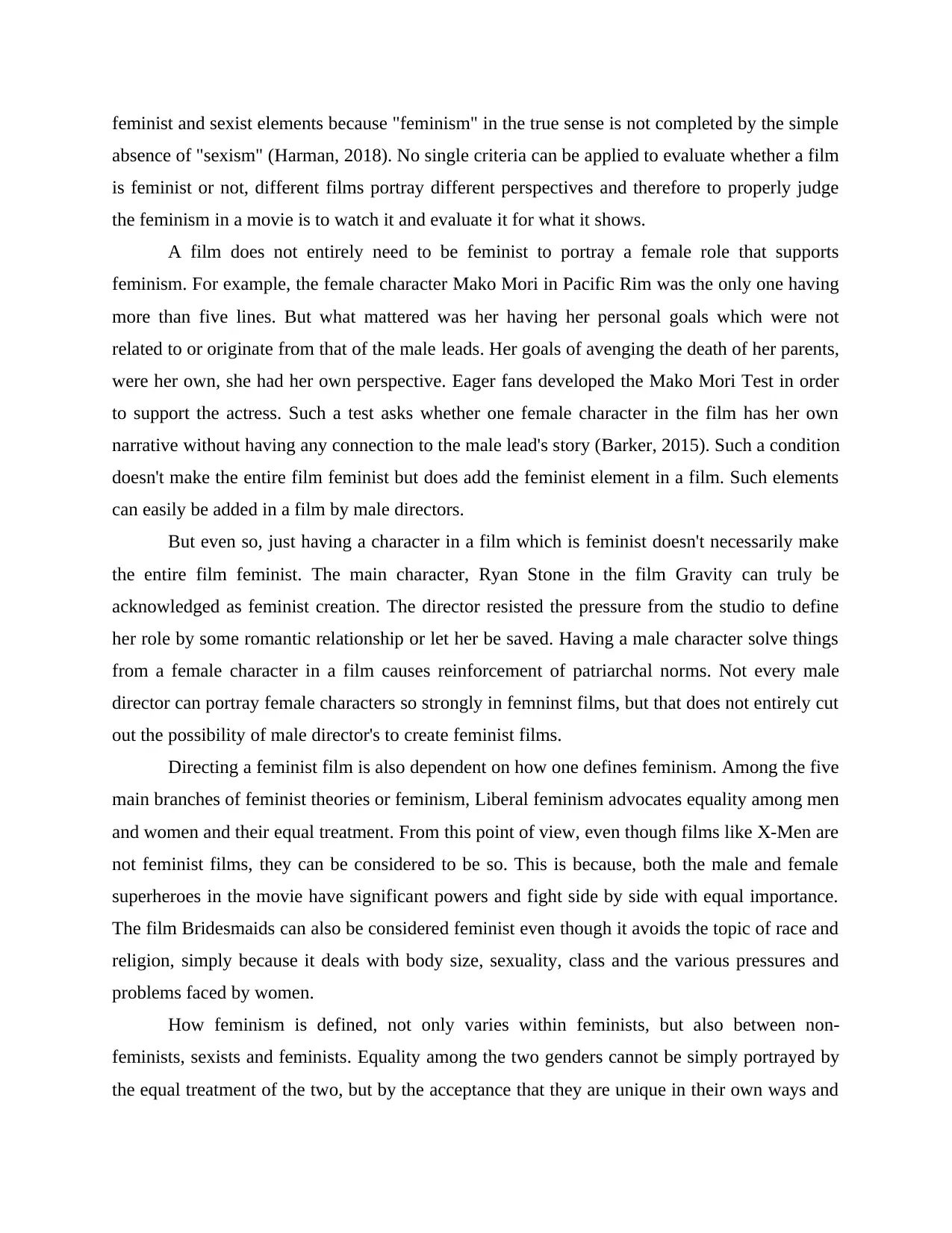
feminist and sexist elements because "feminism" in the true sense is not completed by the simple
absence of "sexism" (Harman, 2018). No single criteria can be applied to evaluate whether a film
is feminist or not, different films portray different perspectives and therefore to properly judge
the feminism in a movie is to watch it and evaluate it for what it shows.
A film does not entirely need to be feminist to portray a female role that supports
feminism. For example, the female character Mako Mori in Pacific Rim was the only one having
more than five lines. But what mattered was her having her personal goals which were not
related to or originate from that of the male leads. Her goals of avenging the death of her parents,
were her own, she had her own perspective. Eager fans developed the Mako Mori Test in order
to support the actress. Such a test asks whether one female character in the film has her own
narrative without having any connection to the male lead's story (Barker, 2015). Such a condition
doesn't make the entire film feminist but does add the feminist element in a film. Such elements
can easily be added in a film by male directors.
But even so, just having a character in a film which is feminist doesn't necessarily make
the entire film feminist. The main character, Ryan Stone in the film Gravity can truly be
acknowledged as feminist creation. The director resisted the pressure from the studio to define
her role by some romantic relationship or let her be saved. Having a male character solve things
from a female character in a film causes reinforcement of patriarchal norms. Not every male
director can portray female characters so strongly in femninst films, but that does not entirely cut
out the possibility of male director's to create feminist films.
Directing a feminist film is also dependent on how one defines feminism. Among the five
main branches of feminist theories or feminism, Liberal feminism advocates equality among men
and women and their equal treatment. From this point of view, even though films like X-Men are
not feminist films, they can be considered to be so. This is because, both the male and female
superheroes in the movie have significant powers and fight side by side with equal importance.
The film Bridesmaids can also be considered feminist even though it avoids the topic of race and
religion, simply because it deals with body size, sexuality, class and the various pressures and
problems faced by women.
How feminism is defined, not only varies within feminists, but also between non-
feminists, sexists and feminists. Equality among the two genders cannot be simply portrayed by
the equal treatment of the two, but by the acceptance that they are unique in their own ways and
absence of "sexism" (Harman, 2018). No single criteria can be applied to evaluate whether a film
is feminist or not, different films portray different perspectives and therefore to properly judge
the feminism in a movie is to watch it and evaluate it for what it shows.
A film does not entirely need to be feminist to portray a female role that supports
feminism. For example, the female character Mako Mori in Pacific Rim was the only one having
more than five lines. But what mattered was her having her personal goals which were not
related to or originate from that of the male leads. Her goals of avenging the death of her parents,
were her own, she had her own perspective. Eager fans developed the Mako Mori Test in order
to support the actress. Such a test asks whether one female character in the film has her own
narrative without having any connection to the male lead's story (Barker, 2015). Such a condition
doesn't make the entire film feminist but does add the feminist element in a film. Such elements
can easily be added in a film by male directors.
But even so, just having a character in a film which is feminist doesn't necessarily make
the entire film feminist. The main character, Ryan Stone in the film Gravity can truly be
acknowledged as feminist creation. The director resisted the pressure from the studio to define
her role by some romantic relationship or let her be saved. Having a male character solve things
from a female character in a film causes reinforcement of patriarchal norms. Not every male
director can portray female characters so strongly in femninst films, but that does not entirely cut
out the possibility of male director's to create feminist films.
Directing a feminist film is also dependent on how one defines feminism. Among the five
main branches of feminist theories or feminism, Liberal feminism advocates equality among men
and women and their equal treatment. From this point of view, even though films like X-Men are
not feminist films, they can be considered to be so. This is because, both the male and female
superheroes in the movie have significant powers and fight side by side with equal importance.
The film Bridesmaids can also be considered feminist even though it avoids the topic of race and
religion, simply because it deals with body size, sexuality, class and the various pressures and
problems faced by women.
How feminism is defined, not only varies within feminists, but also between non-
feminists, sexists and feminists. Equality among the two genders cannot be simply portrayed by
the equal treatment of the two, but by the acceptance that they are unique in their own ways and
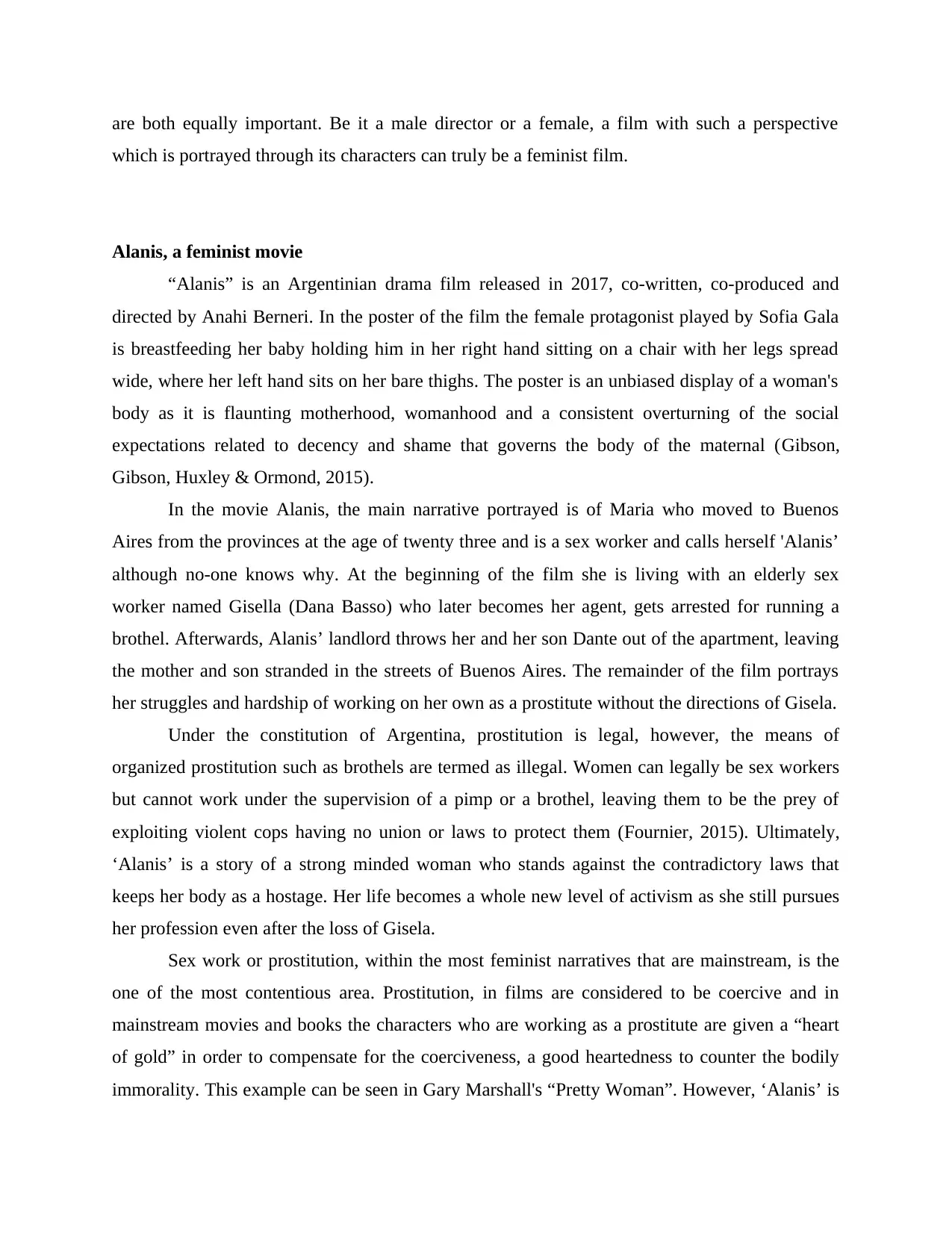
are both equally important. Be it a male director or a female, a film with such a perspective
which is portrayed through its characters can truly be a feminist film.
Alanis, a feminist movie
“Alanis” is an Argentinian drama film released in 2017, co-written, co-produced and
directed by Anahi Berneri. In the poster of the film the female protagonist played by Sofia Gala
is breastfeeding her baby holding him in her right hand sitting on a chair with her legs spread
wide, where her left hand sits on her bare thighs. The poster is an unbiased display of a woman's
body as it is flaunting motherhood, womanhood and a consistent overturning of the social
expectations related to decency and shame that governs the body of the maternal (Gibson,
Gibson, Huxley & Ormond, 2015).
In the movie Alanis, the main narrative portrayed is of Maria who moved to Buenos
Aires from the provinces at the age of twenty three and is a sex worker and calls herself 'Alanis’
although no-one knows why. At the beginning of the film she is living with an elderly sex
worker named Gisella (Dana Basso) who later becomes her agent, gets arrested for running a
brothel. Afterwards, Alanis’ landlord throws her and her son Dante out of the apartment, leaving
the mother and son stranded in the streets of Buenos Aires. The remainder of the film portrays
her struggles and hardship of working on her own as a prostitute without the directions of Gisela.
Under the constitution of Argentina, prostitution is legal, however, the means of
organized prostitution such as brothels are termed as illegal. Women can legally be sex workers
but cannot work under the supervision of a pimp or a brothel, leaving them to be the prey of
exploiting violent cops having no union or laws to protect them (Fournier, 2015). Ultimately,
‘Alanis’ is a story of a strong minded woman who stands against the contradictory laws that
keeps her body as a hostage. Her life becomes a whole new level of activism as she still pursues
her profession even after the loss of Gisela.
Sex work or prostitution, within the most feminist narratives that are mainstream, is the
one of the most contentious area. Prostitution, in films are considered to be coercive and in
mainstream movies and books the characters who are working as a prostitute are given a “heart
of gold” in order to compensate for the coerciveness, a good heartedness to counter the bodily
immorality. This example can be seen in Gary Marshall's “Pretty Woman”. However, ‘Alanis’ is
which is portrayed through its characters can truly be a feminist film.
Alanis, a feminist movie
“Alanis” is an Argentinian drama film released in 2017, co-written, co-produced and
directed by Anahi Berneri. In the poster of the film the female protagonist played by Sofia Gala
is breastfeeding her baby holding him in her right hand sitting on a chair with her legs spread
wide, where her left hand sits on her bare thighs. The poster is an unbiased display of a woman's
body as it is flaunting motherhood, womanhood and a consistent overturning of the social
expectations related to decency and shame that governs the body of the maternal (Gibson,
Gibson, Huxley & Ormond, 2015).
In the movie Alanis, the main narrative portrayed is of Maria who moved to Buenos
Aires from the provinces at the age of twenty three and is a sex worker and calls herself 'Alanis’
although no-one knows why. At the beginning of the film she is living with an elderly sex
worker named Gisella (Dana Basso) who later becomes her agent, gets arrested for running a
brothel. Afterwards, Alanis’ landlord throws her and her son Dante out of the apartment, leaving
the mother and son stranded in the streets of Buenos Aires. The remainder of the film portrays
her struggles and hardship of working on her own as a prostitute without the directions of Gisela.
Under the constitution of Argentina, prostitution is legal, however, the means of
organized prostitution such as brothels are termed as illegal. Women can legally be sex workers
but cannot work under the supervision of a pimp or a brothel, leaving them to be the prey of
exploiting violent cops having no union or laws to protect them (Fournier, 2015). Ultimately,
‘Alanis’ is a story of a strong minded woman who stands against the contradictory laws that
keeps her body as a hostage. Her life becomes a whole new level of activism as she still pursues
her profession even after the loss of Gisela.
Sex work or prostitution, within the most feminist narratives that are mainstream, is the
one of the most contentious area. Prostitution, in films are considered to be coercive and in
mainstream movies and books the characters who are working as a prostitute are given a “heart
of gold” in order to compensate for the coerciveness, a good heartedness to counter the bodily
immorality. This example can be seen in Gary Marshall's “Pretty Woman”. However, ‘Alanis’ is
⊘ This is a preview!⊘
Do you want full access?
Subscribe today to unlock all pages.

Trusted by 1+ million students worldwide
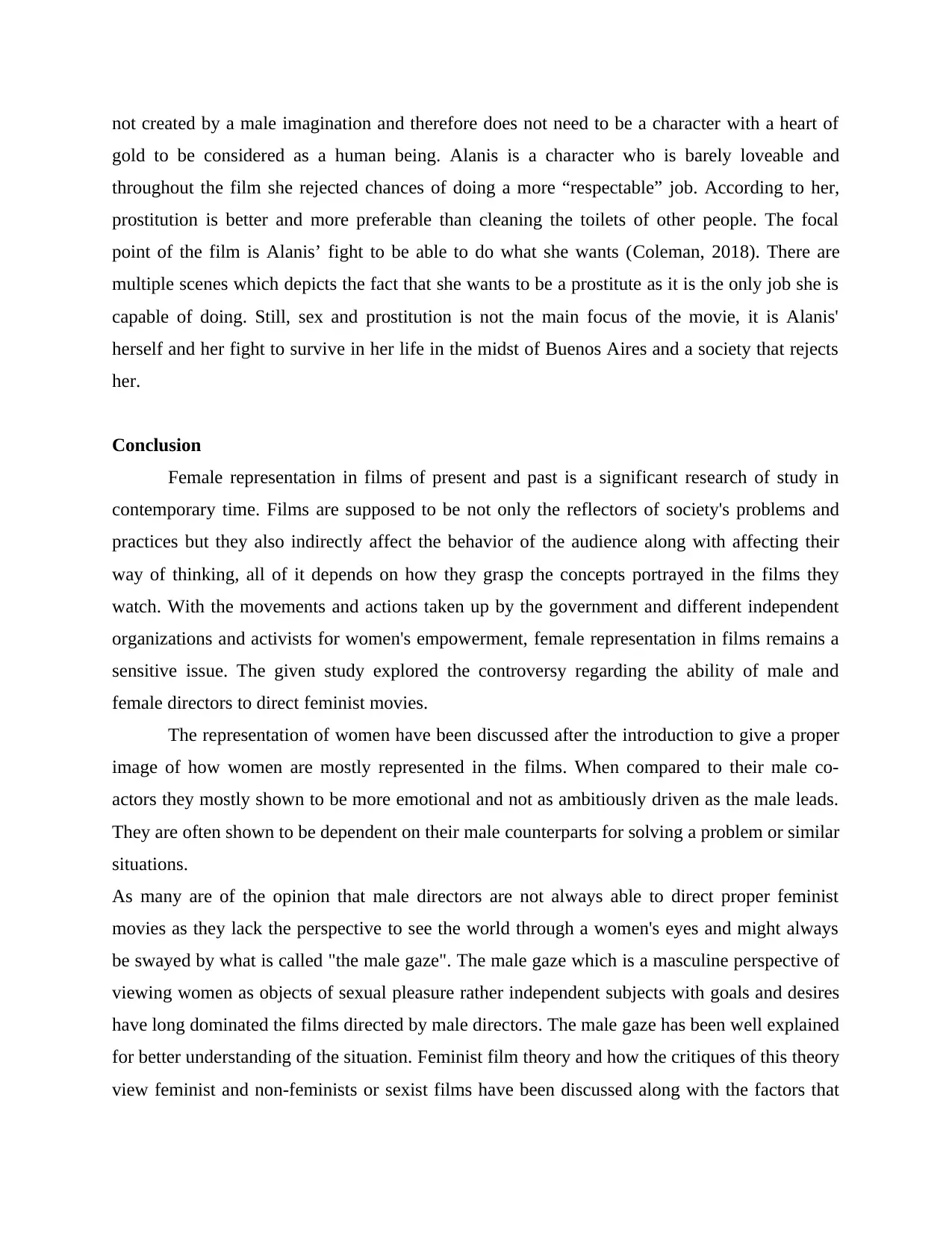
not created by a male imagination and therefore does not need to be a character with a heart of
gold to be considered as a human being. Alanis is a character who is barely loveable and
throughout the film she rejected chances of doing a more “respectable” job. According to her,
prostitution is better and more preferable than cleaning the toilets of other people. The focal
point of the film is Alanis’ fight to be able to do what she wants (Coleman, 2018). There are
multiple scenes which depicts the fact that she wants to be a prostitute as it is the only job she is
capable of doing. Still, sex and prostitution is not the main focus of the movie, it is Alanis'
herself and her fight to survive in her life in the midst of Buenos Aires and a society that rejects
her.
Conclusion
Female representation in films of present and past is a significant research of study in
contemporary time. Films are supposed to be not only the reflectors of society's problems and
practices but they also indirectly affect the behavior of the audience along with affecting their
way of thinking, all of it depends on how they grasp the concepts portrayed in the films they
watch. With the movements and actions taken up by the government and different independent
organizations and activists for women's empowerment, female representation in films remains a
sensitive issue. The given study explored the controversy regarding the ability of male and
female directors to direct feminist movies.
The representation of women have been discussed after the introduction to give a proper
image of how women are mostly represented in the films. When compared to their male co-
actors they mostly shown to be more emotional and not as ambitiously driven as the male leads.
They are often shown to be dependent on their male counterparts for solving a problem or similar
situations.
As many are of the opinion that male directors are not always able to direct proper feminist
movies as they lack the perspective to see the world through a women's eyes and might always
be swayed by what is called "the male gaze". The male gaze which is a masculine perspective of
viewing women as objects of sexual pleasure rather independent subjects with goals and desires
have long dominated the films directed by male directors. The male gaze has been well explained
for better understanding of the situation. Feminist film theory and how the critiques of this theory
view feminist and non-feminists or sexist films have been discussed along with the factors that
gold to be considered as a human being. Alanis is a character who is barely loveable and
throughout the film she rejected chances of doing a more “respectable” job. According to her,
prostitution is better and more preferable than cleaning the toilets of other people. The focal
point of the film is Alanis’ fight to be able to do what she wants (Coleman, 2018). There are
multiple scenes which depicts the fact that she wants to be a prostitute as it is the only job she is
capable of doing. Still, sex and prostitution is not the main focus of the movie, it is Alanis'
herself and her fight to survive in her life in the midst of Buenos Aires and a society that rejects
her.
Conclusion
Female representation in films of present and past is a significant research of study in
contemporary time. Films are supposed to be not only the reflectors of society's problems and
practices but they also indirectly affect the behavior of the audience along with affecting their
way of thinking, all of it depends on how they grasp the concepts portrayed in the films they
watch. With the movements and actions taken up by the government and different independent
organizations and activists for women's empowerment, female representation in films remains a
sensitive issue. The given study explored the controversy regarding the ability of male and
female directors to direct feminist movies.
The representation of women have been discussed after the introduction to give a proper
image of how women are mostly represented in the films. When compared to their male co-
actors they mostly shown to be more emotional and not as ambitiously driven as the male leads.
They are often shown to be dependent on their male counterparts for solving a problem or similar
situations.
As many are of the opinion that male directors are not always able to direct proper feminist
movies as they lack the perspective to see the world through a women's eyes and might always
be swayed by what is called "the male gaze". The male gaze which is a masculine perspective of
viewing women as objects of sexual pleasure rather independent subjects with goals and desires
have long dominated the films directed by male directors. The male gaze has been well explained
for better understanding of the situation. Feminist film theory and how the critiques of this theory
view feminist and non-feminists or sexist films have been discussed along with the factors that
Paraphrase This Document
Need a fresh take? Get an instant paraphrase of this document with our AI Paraphraser
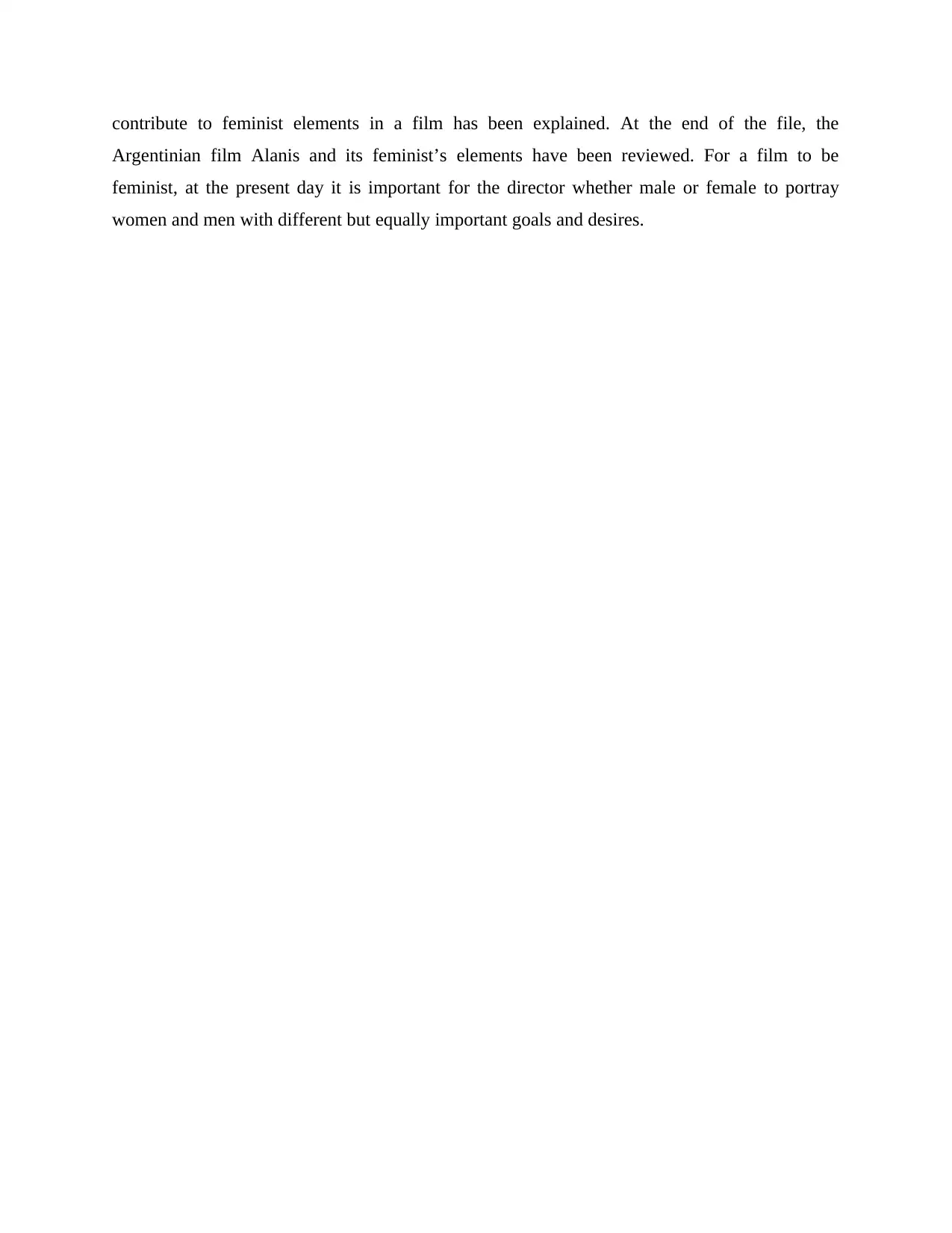
contribute to feminist elements in a film has been explained. At the end of the file, the
Argentinian film Alanis and its feminist’s elements have been reviewed. For a film to be
feminist, at the present day it is important for the director whether male or female to portray
women and men with different but equally important goals and desires.
Argentinian film Alanis and its feminist’s elements have been reviewed. For a film to be
feminist, at the present day it is important for the director whether male or female to portray
women and men with different but equally important goals and desires.
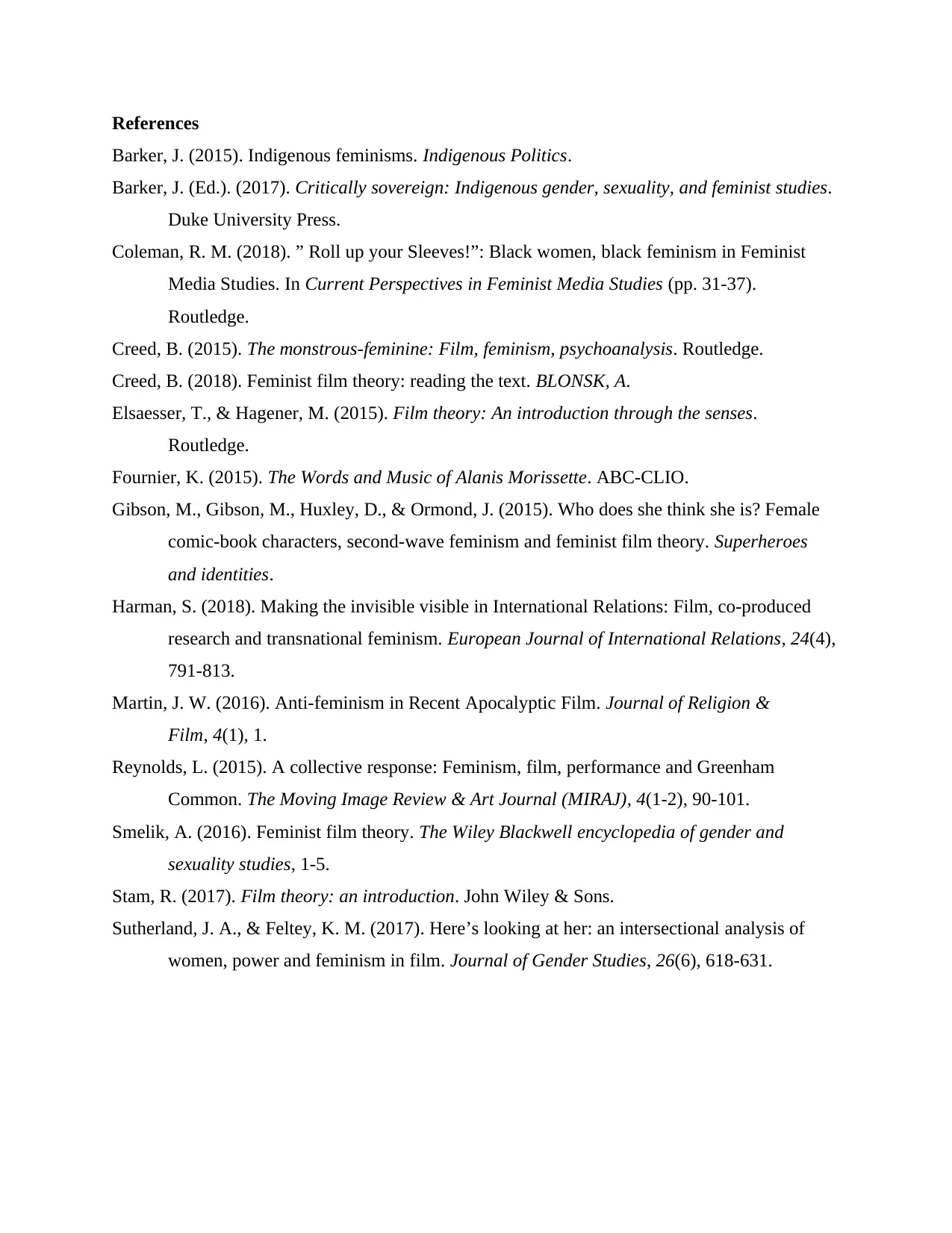
References
Barker, J. (2015). Indigenous feminisms. Indigenous Politics.
Barker, J. (Ed.). (2017). Critically sovereign: Indigenous gender, sexuality, and feminist studies.
Duke University Press.
Coleman, R. M. (2018). ” Roll up your Sleeves!”: Black women, black feminism in Feminist
Media Studies. In Current Perspectives in Feminist Media Studies (pp. 31-37).
Routledge.
Creed, B. (2015). The monstrous-feminine: Film, feminism, psychoanalysis. Routledge.
Creed, B. (2018). Feminist film theory: reading the text. BLONSK, A.
Elsaesser, T., & Hagener, M. (2015). Film theory: An introduction through the senses.
Routledge.
Fournier, K. (2015). The Words and Music of Alanis Morissette. ABC-CLIO.
Gibson, M., Gibson, M., Huxley, D., & Ormond, J. (2015). Who does she think she is? Female
comic-book characters, second-wave feminism and feminist film theory. Superheroes
and identities.
Harman, S. (2018). Making the invisible visible in International Relations: Film, co-produced
research and transnational feminism. European Journal of International Relations, 24(4),
791-813.
Martin, J. W. (2016). Anti-feminism in Recent Apocalyptic Film. Journal of Religion &
Film, 4(1), 1.
Reynolds, L. (2015). A collective response: Feminism, film, performance and Greenham
Common. The Moving Image Review & Art Journal (MIRAJ), 4(1-2), 90-101.
Smelik, A. (2016). Feminist film theory. The Wiley Blackwell encyclopedia of gender and
sexuality studies, 1-5.
Stam, R. (2017). Film theory: an introduction. John Wiley & Sons.
Sutherland, J. A., & Feltey, K. M. (2017). Here’s looking at her: an intersectional analysis of
women, power and feminism in film. Journal of Gender Studies, 26(6), 618-631.
Barker, J. (2015). Indigenous feminisms. Indigenous Politics.
Barker, J. (Ed.). (2017). Critically sovereign: Indigenous gender, sexuality, and feminist studies.
Duke University Press.
Coleman, R. M. (2018). ” Roll up your Sleeves!”: Black women, black feminism in Feminist
Media Studies. In Current Perspectives in Feminist Media Studies (pp. 31-37).
Routledge.
Creed, B. (2015). The monstrous-feminine: Film, feminism, psychoanalysis. Routledge.
Creed, B. (2018). Feminist film theory: reading the text. BLONSK, A.
Elsaesser, T., & Hagener, M. (2015). Film theory: An introduction through the senses.
Routledge.
Fournier, K. (2015). The Words and Music of Alanis Morissette. ABC-CLIO.
Gibson, M., Gibson, M., Huxley, D., & Ormond, J. (2015). Who does she think she is? Female
comic-book characters, second-wave feminism and feminist film theory. Superheroes
and identities.
Harman, S. (2018). Making the invisible visible in International Relations: Film, co-produced
research and transnational feminism. European Journal of International Relations, 24(4),
791-813.
Martin, J. W. (2016). Anti-feminism in Recent Apocalyptic Film. Journal of Religion &
Film, 4(1), 1.
Reynolds, L. (2015). A collective response: Feminism, film, performance and Greenham
Common. The Moving Image Review & Art Journal (MIRAJ), 4(1-2), 90-101.
Smelik, A. (2016). Feminist film theory. The Wiley Blackwell encyclopedia of gender and
sexuality studies, 1-5.
Stam, R. (2017). Film theory: an introduction. John Wiley & Sons.
Sutherland, J. A., & Feltey, K. M. (2017). Here’s looking at her: an intersectional analysis of
women, power and feminism in film. Journal of Gender Studies, 26(6), 618-631.
⊘ This is a preview!⊘
Do you want full access?
Subscribe today to unlock all pages.

Trusted by 1+ million students worldwide
1 out of 9
Your All-in-One AI-Powered Toolkit for Academic Success.
+13062052269
info@desklib.com
Available 24*7 on WhatsApp / Email
![[object Object]](/_next/static/media/star-bottom.7253800d.svg)
Unlock your academic potential
Copyright © 2020–2025 A2Z Services. All Rights Reserved. Developed and managed by ZUCOL.
